Darjeeling
Author: Günter Burkhardt
Publisher: Abacusspiele
Year: 2007
review by

| x |
|
|
|
|
|
|
|
|
|
|
|
|
|
|
|
|
|
|
|
|
|
|
|
|
|
|
|
|
|
|
|
|
|
|
|
|
|
|
|
|
|
|
|
|
|
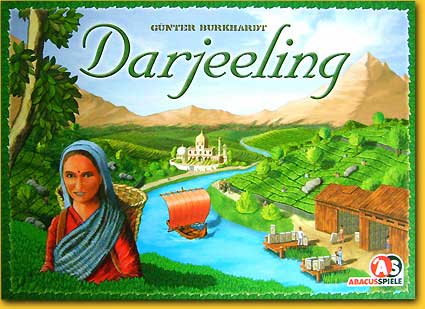 x x |
We are going to India, China or Sri Lanka, take your pick, to look for the highest quality of tea. After neatly wrapping it up in crates, we sell them at the local wharf. But the tea prices are subject to change: our customers prefer only the freshest leaves. Crates that have been waiting at the dock for some time are regarded as inferior, and they are shoved to the crummy quays in the desolate area of the wharf. There, the precious leaves are sold for very low prices to customers that are more concerned with their wallet than with the quality of the product. |
| x |
|
|
|
|
|
|
|
|
|
|
|
|
|
|
|
|
|
|
|
|
|
|
|
|
|
|
|
|
|
|
|
|
|
|
|
|
|
|
|
|
|
|
|
|
|
| On the board, which is mainly composed of a scoring track, ships are placed next to the three to seven quays, depending on the number of players. On the chute of the wharf, the demand markers, that symbolise the demand for the four different brands of tea, are loaded in random order. The playing area is composed of tea tiles displaying one, two or three half crates of tea in one of the four colours, and three city tiles. All players place one container in their colour on one of the ships, and they place their tea collector at the border of the playing area. |
| x |
|
|
|
|
|
|
|
|
|
|
|
|
|
|
|
|
|
|
|
|
|
|
|
|
|
|
|
|
|
|
|
|
|
|
|
|
|
|
|
|
|
|
|
|
|
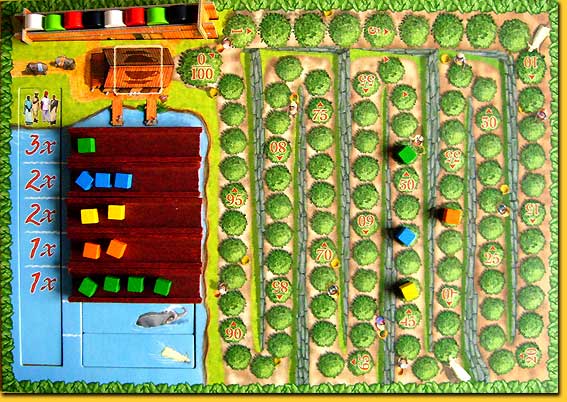 |
| x |
|
|
|
|
|
|
|
|
|
|
|
|
|
|
|
|
|
|
|
|
|
|
|
|
|
|
|
|
|
|
|
|
|
|
|
|
|
|
|
|
|
|
|
|
|
| A player’s turn starts with scoring. The quays all have a multiplier value of 3 (top), 2 or 1 (bottom); the number of crates the player has loaded on a ship is multiplied by this factor, and the points are added to his total. Next, the player has to move his tea collector. |
|
| x |
|
|
|
|
|
|
|
|
|
|
|
|
|
|
|
|
|
|
|
|
|
|
|
|
|
|
|
|
|
|
|
|
|
|
|
|
|
|
|
|
|
|
|
|
|
| He may rotate the collector by 90º before moving, and he may move one step for free. Rotating by 180º costs 2 points, moving additional steps costs 1 point per step, and jumping over cities or opponents’ tea collectors costs 2 points. He may not change direction during movement! The player puts the tea tile where his collector ends his movement behind his screen. The hole left in the playing area by the collector is refilled with a random tea tile from the bag. |
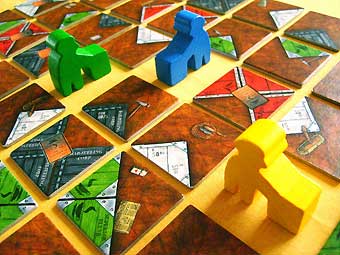 |
| x |
|
|
|
|
|
|
|
|
|
|
|
|
|
|
|
|
|
|
|
|
|
|
|
|
|
|
|
|
|
|
|
|
|
|
|
|
|
|
|
|
|
|
|
|
|
 |
x |
Subsequently, the player is allowed to load crates onto the ships. The tea tiles he has collected behind his screen all show half crates, and by putting multiple tiles together, whole crates can be assembled. A player may load as many containers in his colour as the number of crates he assembled. The crates all have to be of the same brand (colour) of tea. Additionally, his tea collector must be adjacent to a city tile in the playing area. It is not a disaster if the latter criterium is not met: he simply loads one container less as a penalty. He takes the ship from the bottom quay, removes any containers on it, and places his own containers on the ship. Then, all remaining ships are pushed down, and he inserts his freshly loaded ship at the top position, the one with the highest multiplier.
He receives points for this, based on the position of the demand markers on the chute. The bottom marker of the colour he just shipped is removed, and reinserted ad the top. Now, the number of demand markers between the two markers of this colour is determined; this is the number of points awarded to the player. |
| x |
|
|
|
|
|
|
|
|
|
|
|
|
|
|
|
|
|
|
|
|
|
|
|
|
|
|
|
|
|
|
|
|
|
|
|
|
|
|
|
|
|
|
|
|
|
| There is an additional bonus for large suppliers: if a player ships four or more containers, he receives one additional point per container. |
|
 |
| x |
|
|
|
|
|
|
|
|
|
|
|
|
|
|
|
|
|
|
|
|
|
|
|
|
|
|
|
|
|
|
|
|
|
|
|
|
|
|
|
|
|
|
|
|
|
|
|
|
|
Then there’s the action tiles; when a player takes a tea tile displaying three crates, he may take an action tile. They are double-sided, and the player may choose which side he uses.
|
| x |
|
|
|
|
|
|
|
|
|
|
|
|
|
|
|
|
|
|
|
|
|
|
|
|
|
|
|
|
|
|
|
|
|
|
|
|
|
|
|
|
|
|
|
|
|
One side gives him the option to load the full number of containers, even if his tea collector is not adjacent to a city, and the other side allows him to double his demand bonus. The tiles are discarded after use.
The game is over as soon as a player reaches or exceeds 100 points on the scoring track. Each half crate on the tea tiles the players still have behind their screen is one penalty point. |
| x |
|
|
|
|
|
|
|
|
|
|
|
|
|
|
|
|
|
|
|
|
|
|
|
|
|
|
|
|
|
|
|
|
|
|
|
|
|
|
|
|
|
|
|
|
|
| x |
|
|
|
|
|
|
|
|
|
|
|
|
|
|
|
|
|
|
|
|
|
|
|
|
|
|
|
|
|
|
|
|
|
|
|
|
|
|
|
|
|
|
|
|
|
| x |
|
|
|
|
|
|
|
|
|
|
|
|
|
|
|
|
|
|
|
|
|
|
|
|
|
|
|
|
|
|
|
|
|
|
|
|
|
|
|
|
|
|
|
|
|
 |
|
|
|
|
|
|
|
|
|
|
|
|
|
|
|
|
|
|
|
|
|
|
|
|
|
|
|
|
|
|
|
|
|
|
|
|
|
|
|
|
|
| One nagging remark on the scoring track: it zigzags so much that it becomes impossible to tell who is ahead. At times during scoring, the players pawns accidentally are moved backward instead of forward, since it is so hard to see in which direction the track goes. So much for details. Apart from that, the design is fine. The wooden ships can easily be transferred to the right quay, and the wharf chute that determines the demand bonus is a great idea and well executed too. One funny detail is that the tea collectors with their baskets can also be interpreted as old folks with a walker. In India or China, people probably don’t retire at a mere 65... |
| x |
|
|
|
|
|
|
|
|
|
|
|
|
|
|
|
|
|
|
|
|
|
|
|
|
|
|
|
|
|
|
|
|
|
|
|
|
|
|
|
|
|
|
|
|
|
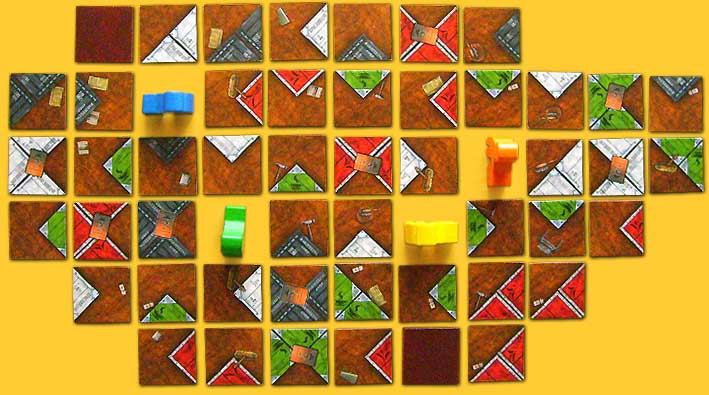 |
| x |
|
|
|
|
|
|
|
|
|
|
|
|
|
|
|
|
|
|
|
|
|
|
|
|
|
|
|
|
|
|
|
|
|
|
|
|
|
|
|
|
|
|
|
|
|
|
Darjeeling has a nice mechanism. You score points for your containers only at the beginning of your turn, and upon loading, all other boats are pushed down to the quays with lower multipliers. Therefore it is possible that you never get the full score for your shipping efforts; if your opponents immediately start to load containers themselves, your boat can be down at a ‘1x-multiplier’ quay when it’s your turn! If you manage to get a good position at the wharf, it is not in your own interest to do more shipping, since you will push your own ships down in the process.
|
| x |
|
|
|
|
|
|
|
|
|
|
|
|
|
|
|
|
|
|
|
|
|
|
|
|
|
|
|
|
|
|
|
|
|
|
|
|
|
|
|
|
|
|
|
|
|
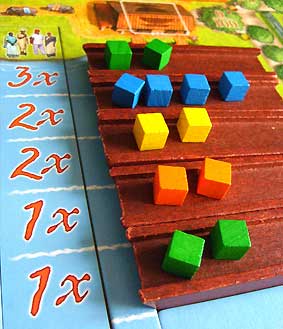 |
|
The other players will have to take their responsibility! Even if they can only load one pathetic little container of a colour with a low demand bonus... Despite this, there is only little player interaction in this game. In the playing area with the tea collectors, you are hardly ever in each other’s way, and if someone happens to be where you would like to go, you can easily go the other way, because the tea tile you were aiming for is bound to be present at multiple locations on the board. The only interaction is in the shipping; if another player is scoring really well, you sometimes have to load something yourself to push him down, even if it’s not really in your own best interest. It is also annoying if somebody loads crates of a colour that you were also collecting, because the demand bonus will temporarily drop to 0, but you can hardly call that ‘player interaction’.
|
| x |
|
|
|
|
|
|
|
|
|
|
|
|
|
|
|
|
|
|
|
|
|
|
|
|
|
|
|
|
|
|
|
|
|
|
|
|
|
|
|
|
|
|
|
|
|
The optimal number of players for Darjeeling is 3 or 4; with two players there’s not enough competition and it really becomes like playing solitaire, and with five players the situation has changed so much by the time it’s your turn again, making it impossible to plan anything. This is clearly a game in the category: everything works, it even has some nice elements, but nothing is really shocking or innovative, and we are not really on the edges of our seats during the game.
© 2008 Barbara van Vugt
Darjeeling, Günter Burkhardt, Abacusspiele, 2007 - 2 to 5 players, 12 years and up, 60 minutes
|
  |
|
|
|
|
|
|
|
|
|
|
|
|
|
|
|
|
|
|
|
|
|
|
|
|
|
|
|
|
|
|
|
|
|
|
|
|
|
|
|
|
|
  |
|
|
|
|
|
|
|
|
|
|
|
|
|
|
|
|
|
|
|
|
|
|
|
|
|
|
|
|
|
|
|
|
|
|
|
|
|
|
|
|
|
  |
|
|
|
|
|
|
|
|
|
|
|
|
|
|
|
|
|
|
|
|
|
|
|
|
|
|
|
|
|
|
|
|
|
|
|
|
|
|
|
|
|
  |
|
|
|
|
|
|
|
|
|
|
|
|
|
|
|
|
|
|
|
|
|
|
|
|
|
|
|
|
|
|
|
|
|
|
|
|
|
|
|
|
|
  |
|
|
|
|
|
|
|
|
|
|
|
|
|
|
|
|
|
|
|
|
|
|
|
|
|
|
|
|
|
|
|
|
|
|
|
|
|
|
|
|
|
| x |
|
|
|
|
|
|
|
|
|
|
|
|
|
|
|
|
|
|
|
|
|
|
|
|
|
|
|
|
|
|
|
|
|
|
|
|
|
|
|
|
|
|
|
|
|
| x |
|
|
|
|
|
|
|
|
|
|
|
|
|
|
|
|
|
|
|
|
|
|
|
|
|
|
|
|
|
|
|
|
|
|
|
|
|
|
|
|
|
|
|
|
|
 |
|
|
|
|
|
|
|
|
|
|
|
|
|
|
|
|
|
|
|
|
|
|
|
|
|
|
|
|
|
|
|
|
|
|
|
|
|
|
|
|
|
 |
|
|
|
|
|
|
|
|
|
|
|
|
|
|
|
|
|
|
|
|
|
|
|
|
|
|
|
|
|
|
|
|
|
|
|
|
|
|
|
|
|
| x |
|
|
|
|
|
|
|
|
|
|
|
|
|
|
|
|
|
|
|
|
|
|
|
|
|
|
|
|
|
|
|
|
|
|
|
|
|
|
|
|
|
|
|
|
|
 |
|
|
|
|
|
|
|
|
|
|
|
|
|
|
|
|
|
|
|
|
|
|
|
|
|
|
|
|
|
|
|
|
|
 |
|
|
|
|
|
|
|
|
|
|
|
|
|
|
|
|
|
|
|
|
|
|
|
|
|
|
|
|
|
|
|
|
|
|
|